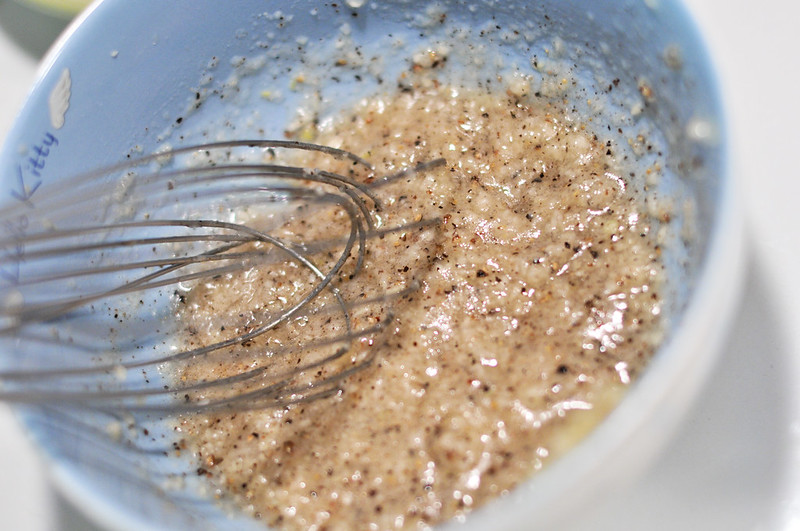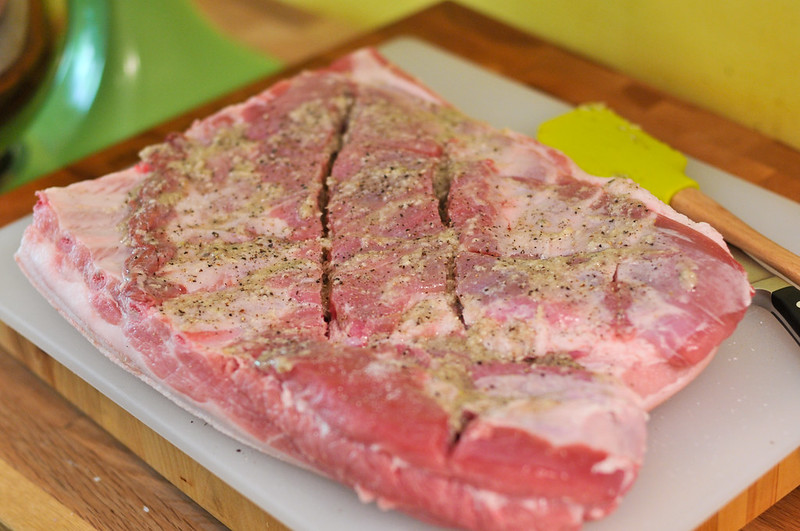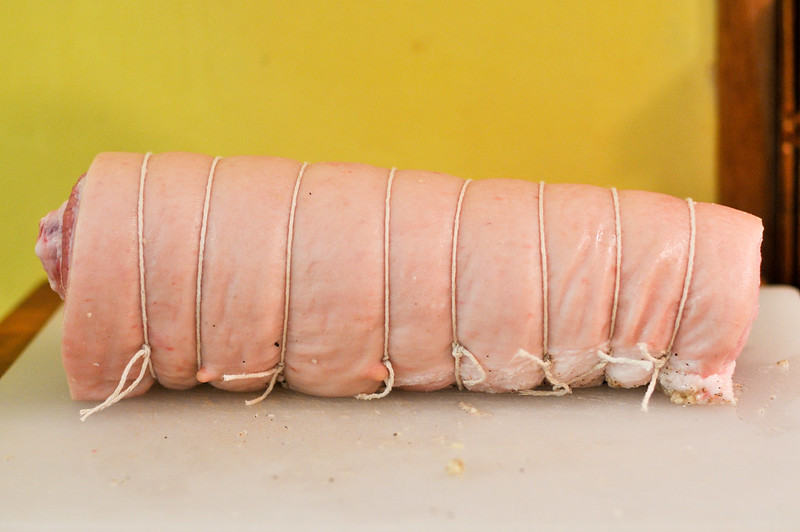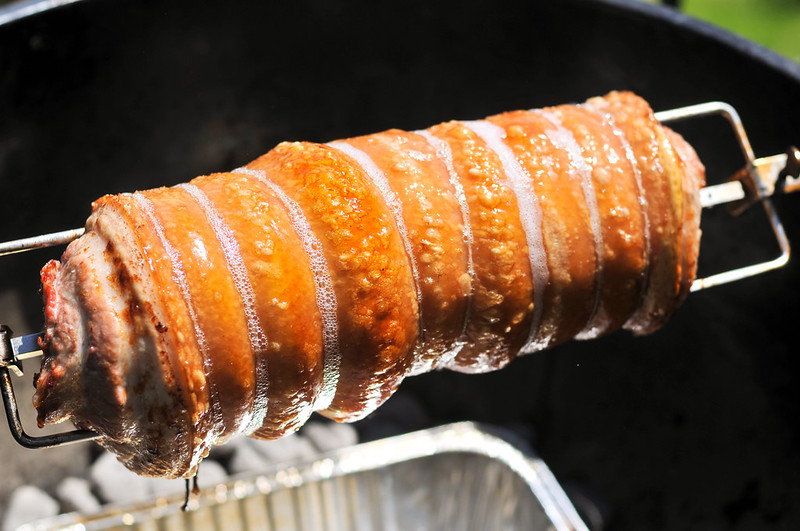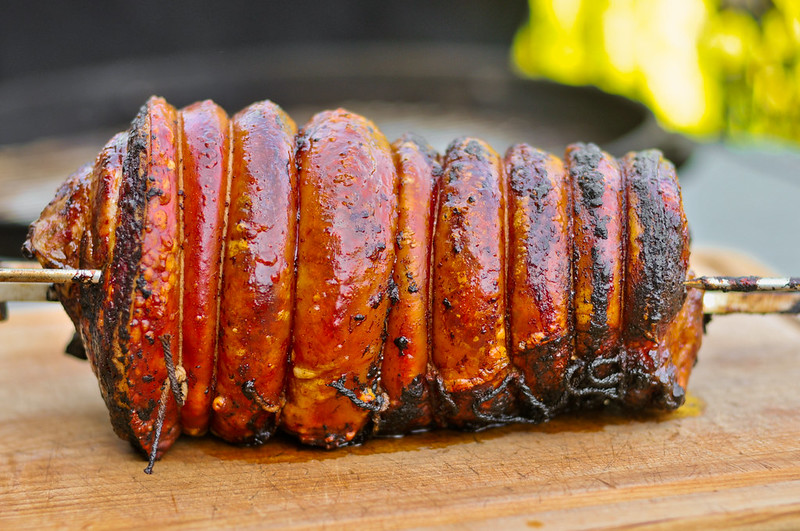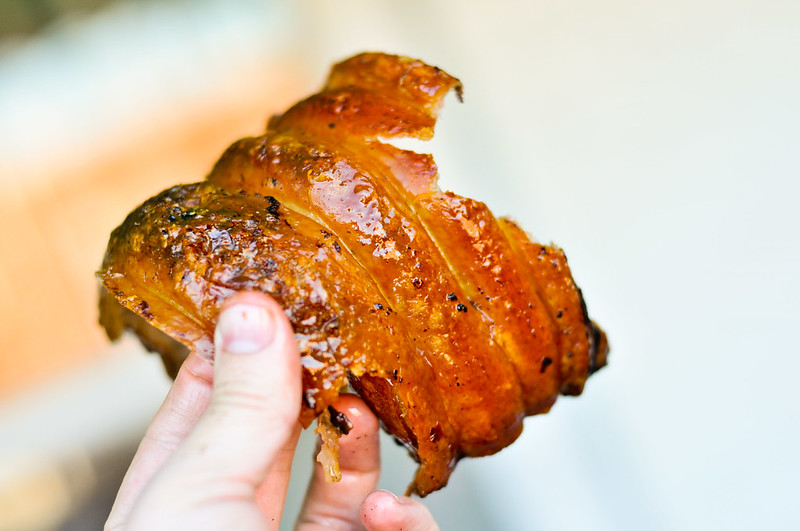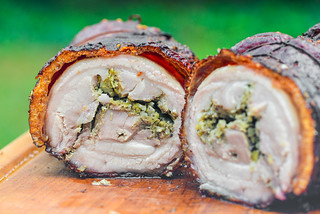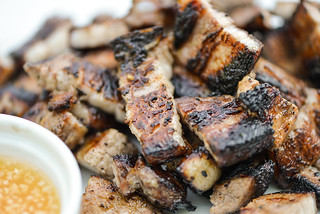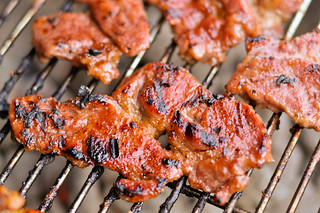Lechon Liempo
I may talk a barbecue game, but when it comes to cooking swine, Filipinos are at the top of their game. For all the Carolina whole hogs, smoked pork shoulders, and braised bellies I've had, nothing quite matches the simplicity and utter mastery of Filipino lechon—whole roast pig. I'd love nothing more than to learn this fine art of rotisserie swine cooking, but I'm short on a giant rotisserie, hogs, and a mentor. So when wanting to do some Filipino style pork, I took things to a smaller scale and looked to lechon liempo—Filipino roast pork belly.
I'm not sure if lechon is made with anything more than a pig and fire, but I thought it would be apt to inject a little extra flavor into this pork belly. So I started the recipe out with the ubiquitous Filipino flavors of garlic and vinegar, working the two into a paste with some salt and oil as well.
I then laid open the glorious seven pound hunk of belly I picked up at my butcher. To ensure the flavor of the garlic paste was spread throughout the belly, I scored the meat, creating valleys for the paste to seep into as it was spread across the entire surface.
The belly was then rolled up and I had a chance to practice my meat tying skills. I did a decent job, secure the roll about every inch, forming it into a pretty even cylinder ready to be thread onto the spit.
I started the belly over high heat—right after the coals were lit. This had the skin browning and starting to blister rather quickly. I actually thought if I left it on the entire time it would need to cook—between two and three hours—I would end up burning the skin by the end. Luckily the temperature dropped and held steady in the 300-325 degree range, which was the right temp to finish the skin to a perfect crackle at the same time the meat was cooked through.
What came off the spit was a sight for sore eyes. There was a little unevenness in the skin towards one end of the belly, but that's of little importance, as it did nothing to hold back the sheer awesomeness of the juicy, flavorful belly meat and the salty, crunchy rind. The garlic paste gave a nice addition to the roll, but it was the fatty, luscious belly meat and fat that dominated.
Let's not forget the best of the best, the skin! Man, this rind that was self basted to its crackling finale is something to live life for. It's best when some of that melty pork fat is still attached, adding flavor and juiciness to the skin. After we were sufficiently stuffed from gorging on this pork roll, our protruding stomaches still cried out for more of the good stuff, so the skin was divorced from its meat and passed around to cap off on fantastic piece of lechon liempo.
You Might Also Like
Comments
-
bkhuna If ever there was food porn....
-
Phil in France Did you debone the belly? Pork belly here comes with a few rib bones intact...
-
Josh @Phil I did not de-bone this, but making it a second time, I would. The bones made it hard to slice and caused the bit of unevenness you can see in the photo of the tied belly, where one side is a little thicker than the other.
-
Chris I have arrived at the church of bacon!
-
bkhuna I made this for fathers day. It came out better than I had hoped.
-
Alex I'm going to try this today (with a tenderloin in the middle) - what do you think about puncturing the skin a bunch to let some of the fat seep out?
-
bkhuna Alex, if you're using commercial pork, there is less fat under the skin than you think. If I was going to cook a piece of tenderloin (an inherently lean cut), I would think the fat would help the tenderloin moist.
I'd be careful about the cooking time also. To get the tenderloin done to your liking will require the addition of extra time which may cause over cooking the skin. The skin really is a treat.
I'd like to see how yours comes out! -
Alex It turned out amazing! Posted some photos of the process and final product.
https://twitter.com/acce/status/356564381699563520/photo/1
https://twitter.com/acce/status/356564746046148608/photo/1 -
bkhuna Alex - Did you puncture? How did you cook it? It looks wonderful.
-
candice I cook my pork belly with 375 for an 1 I/2 for a 5lbs meat then blast the oven to 400-450 for another 30 minutes. the skin is to die for. I brine it with sugar, salt an tamarind for few hours
-
Pablo Two years after gifting me a 22.5" Weber grill, my friends followed that up with a rotisserie attachment this year.
After successfully using it with your apple smoked turkey for Thanksgiving just a few weeks ago, I decided I'd give this recipe a go once spring arrived and it was comfortable to be outside again (I live in Chicago).
Some warm weather sneaked in this weekend and I figured it was now or never (or, you know, spring). I picked up a slab of boneless pork belly and threw it on.
This was easily the best thing I've cooked all year and the best pork belly I've ever eaten. I used to think decadent pork belly was something reserved for the lofty restaurants I treat myself to every so often. It was incredibly rewarding to surpass that quality in my own backyard.
The skin was salty (even though I was worried it wouldn't be since the recipe didn't call to sprinkle any directly on the skin) and crackly. The meat was tender and juicy, bursting with the simple, but delicious flavor of garlic.
I can't wait to do this again once the weather warms up and show this off to friends. -
john This a great and simple recipe although i added a minor detail by adding a stalk of lemongrass thats been bruised up in the middle when i rolled up the belly
-
Vince I don't doubt it's taste but for it to be Filipino. You need Lemmongrass
-
JJ What's considered medium heat? 325? 350?
-
Josh @JJ Exactly. Here's my guide for temperature ranges.

